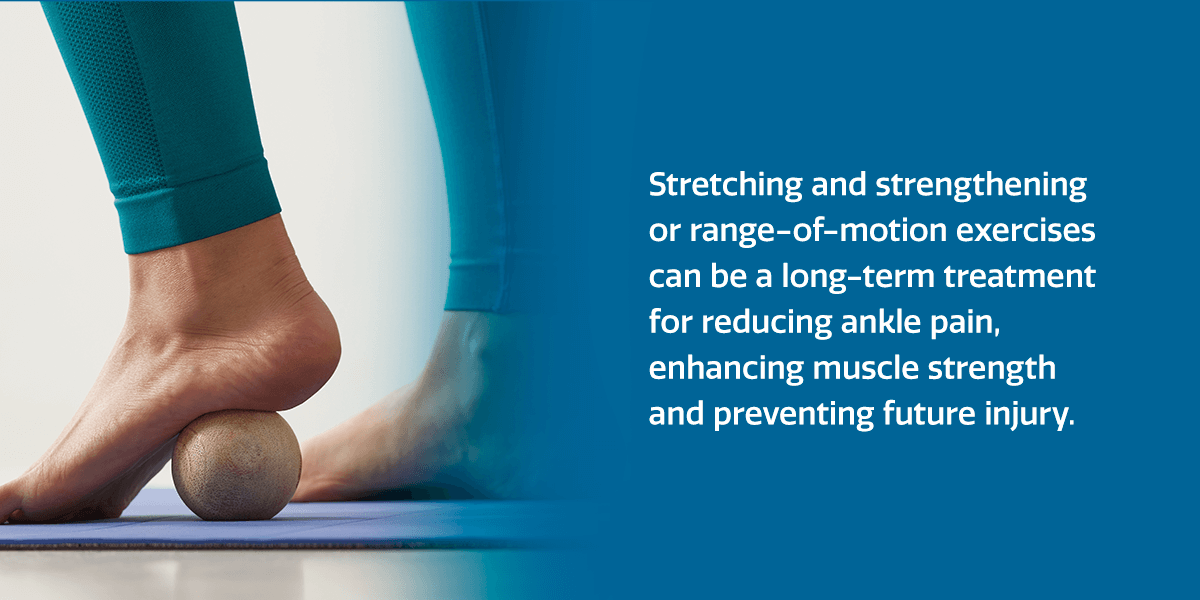
Ankle pain can affect your movement, balance, comfort and quality of life. It can stop you from doing the things you love, like exercising or picking up your kids. If you have been living with chronic ankle pain, we’re here to tell you that there are ways to relieve short and long-term discomfort. And you can do so with various at-home remedies and treatment plans. Here’s how to relieve ankle pain at home.
1. RICE
Rest, ice, compression and elevation (RICE) is one of the most common ankle pain home remedies. Following a RICE treatment plan can effectively reduce ankle pain, swelling and inflammation. While your doctor can recommend therapy based on the type and severity of your ankle pain, here is what a RICE treatment can consist of:
- Rest: Avoid physical activity and strenuous movement to stabilize the injured area and prevent straining the ankle further.
- Ice: Ice treatment can be excellent for relieving ankle swelling and discomfort. Icing your ankle can include applying a cold pack or compress to the affected area and can be done after heat therapy. Remember to avoid using ice directly on your skin.
- Compression: Gently wrap your ankle with a bandage to add pressure to the area, helping promote blood circulation and alleviate pain.
- Elevation: If you can, keep your leg raised above your heart when sitting down to drain excess fluid from the injury site and reduce pressure and discomfort.
2. Pain Medication
You can take non-steroidal anti-inflammatory drugs as part of an at-home ankle pain relief plan. Medications like Ibuprofen can help reduce inflammation and discomfort. Using anti-inflammatory medications according to a doctor’s or a pharmacist’s recommended dosage and treatment period is essential.
3. Heat Treatment
Another common ankle pain treatment is heat therapy. Depending on your ankle injury, you can apply a heat pack to the affected area to promote blood flow, reduce pain and tension and relax your muscles. Avoid using heat on a swollen area, as it can enhance inflammation.
4. Stretching Exercises

Stretching and strengthening or range-of-motion exercises can be a long-term treatment for reducing ankle pain, enhancing muscle strength and preventing future injury. You can gently stretch your ankle in different directions daily to minimize stiffness and pain.
Flexing and moving your feet backward, forward and around can also enhance circulation and help relieve pain. While stretching can be a great way to reduce ankle pain, you must consider your type of injury and pain severity before trying various exercises. Avoid stretching before you’re able, especially if you have severe pain or can’t move your ankle.
5. Epsom Salt Bath
Soaking in a warm bath with Epsom salts is another excellent long-term ankle pain treatment. Ice and other cold treatments might be best when treating initial pain, swelling and inflammation. However, once inflammation and swelling subside, a warm bath in Epsom salts can help relax stiff muscles, promote blood flow and soothe chronic or ongoing ankle pain.
If you are experiencing early stages of ankle pain, like severe discomfort, swelling and inflammation, avoid using heat and Epsom salt treatments until after these symptoms subside.
6. Herbal Solutions
Massaging your injured ankle with natural ingredients like coconut, cabbage leaf and turmeric may help reduce swelling, inflammation and pain. Here are some herbal or natural remedies for ankle pain:
- Herbal pain-reducing rub: Mix and warm ingredients like turmeric, coconut, olive and garlic oil to create rub. Use this rub to lightly massage the affected area, allowing the ingredient to soak into your skin and help reduce pain and inflammation.
- Natural anti-inflammatory: Cabbage can work as a natural anti-inflammatory, helping reduce fluids in the affected area and providing essential minerals for pain relief. Blanch cabbage leaves in boiling water, remove them immediately and place them in an ice container. Let the leaves soak and cool down in the ice water before wrapping them around your foot and ankle. Leave them on for about 30 minutes and remove.
7. Suitable Footwear and Orthotics
Wearing shoes with arch support and cushioning can enhance comfort and reduce foot and ankle pain. Orthotics is another way to improve mechanical alignment, reduce long-term ankle pain and prevent further injury. You can get orthotic shoe inserts from your local pharmacy to help alleviate ankle discomfort.
These orthotics can work best for people with general height, weight and shoe sizes. If your ankle pain is caused by arthritis, tendonitis and flat feet, you’ll need more specialized orthotics. Your foot and ankle specialist physician can prescribe custom orthotics as part of the treatment plan after a medical examination. A specialized orthotic treatment plan can effectively alleviate pain and rectify ankle issues.
Types of Ankle Pain
You can experience various types of ankle pain due to arthritis, fractures and sprains. Here are common types of ankle pain you might encounter:
- Sprains: These injuries can impact the joints and ligaments in your ankles, causing upper, back, outer and inner ankle discomfort. You can also experience swelling and bruising. Ankle pain from sprains can vary depending on the severity of your injury.
- Fractures: Stress and regular fractures can cause pain and discomfort in your ankle, foot, leg and knee. This pain can be more intense depending on the injury site and fracture type. Ankle pain from fractures can occur immediately or worsen when you walk or do physical activity.
- Arthritis: If you have foot and ankle arthritis, you can experience joint pain and stiffness when moving. You might also experience discomfort when bearing weight on your affected ankle and have difficulty moving. The pain might worsen when sleeping and sitting.
- Tendonitis: You can experience localized pain and swelling in the affected ankle tendon. This discomfort might worsen when moving, walking or playing sports and subside when resting.
- Gout: If you have gout, you may experience severe ankle pain when moving and walking. This discomfort can occur in your joints, causing difficulty and pain when walking, especially down the stairs or sloped areas.
Rely on Foot & Ankle Surgical Associates for Ankle Pain Relief
Ongoing ankle pain can be debilitating and impact your well-being. Professional care and a custom treatment plan can relieve ankle pain and enhance your comfort at home, work or wherever you are, helping you enjoy the activities you love. So, why should you live in constant discomfort?
Foot & Ankle Surgical Associates offers expert and comprehensive ankle pain treatment, including orthotics and physical therapy. Our dedicated staff provides a custom treatment plan, helping you successfully alleviate ankle pain at home and resolve related conditions.
Fill out an online form today to start the journey toward long-term and effective ankle pain treatment.





